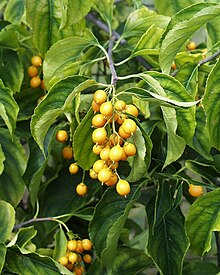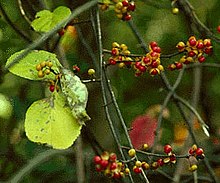
Dalbergia is a large genus of small to medium-size trees, shrubs and lianas in the pea family, Fabaceae, subfamily Faboideae. It was recently assigned to the informal monophyletic Dalbergia clade : the Dalbergieae. The genus has a wide distribution, native to the tropical regions of Central and South America, Africa, Madagascar and southern Asia.

Menispermum (moonseed) is a small genus of deciduous climbing woody vines in the moonseed family (Menispermaceae). Plants in this genus have small dioecious flowers, and clusters of small grape-like drupes. The name, moonseed, comes from the shape of the seed, which resembles a crescent moon. The word Menispermum is derived from the Greek words μήν (mēn), meaning (crescent) moon, and σπέρμα (sperma) meaning seed. The common name moonseed is also applied to some other species in the related genus Cocculus.

The Celastraceae are a family of 97 genera and 1,350 species of herbs, vines, shrubs and small trees, belonging to the order Celastrales. The great majority of the genera are tropical, with only Celastrus, Euonymus and Maytenus widespread in temperate climates, and Parnassia (bog-stars) found in alpine and arctic climates.

Elaeagnus, silverberry or oleaster, is a genus of about 50–70 species of flowering plants in the family Elaeagnaceae.

Stewartia is a genus of 8-20 species of flowering plants in the family Theaceae, related to Camellia. Most of the species are native to eastern Asia in China, Japan, Korea, Laos, Myanmar, Thailand, and Vietnam, with two in southeast North America, from Virginia and Kentucky south to Florida and Louisiana.

Cocculus is a genus of 11 species of woody vines and shrubs, native to warm temperate to tropical regions of North America, Asia and Africa. The common name moonseed is also used for the closely related genus Menispermum.

Celastrus orbiculatus is a woody vine of the family Celastraceae. It is commonly called Oriental bittersweet, as well as Chinese bittersweet, Asian bittersweet, round-leaved bittersweet, and Asiatic bittersweet. It is native to China, where it is the most widely distributed Celastrus species, and to Japan and Korea. It was introduced into North America in 1879, and is considered to be an invasive species in eastern North America. It closely resembles the native North American species, Celastrus scandens, with which it will readily hybridize.

Perrottetia is a genus of flowering plants in the family Dipentodontaceae described as a family in 1824. Species occur in China, Southeast Asia, Papuasia, Hawaii, Australia, and Latin America. It is the largest genus of the recently described order Huerteales.

Ormosia is a genus of legumes. 131 living species, mostly trees or large shrubs, are native to the tropical Americas, from southwestern Mexico to Bolivia and southern Brazil, to southern, southeastern, and eastern Asia, and to New Guinea and Queensland. Most are tropical, while some extend into temperate temperate regions of China. A few species are threatened by habitat destruction, while the Hainan ormosia is probably extinct already.
Glyptopetalum is a genus of plant in the family Celastraceae.

Gymnosporia is an Old World genus of plants, that comprise suffrutices, shrubs and trees. It was formerly considered congeneric with Maytenus, but more recent investigations separated it based on the presence of achyblasts and spines, alternate leaves or fascicles of leaves, an inflorescence that forms a dichasium, mostly unisexual flowers, and fruit forming a dehiscent capsule, with an aril on the seed. It is dioecious, with male and female flowers on separate plants.

Callicarpa (beautyberry) is a genus of shrubs and small trees in the family Lamiaceae. They are native to east and southeast Asia, Australia, Madagascar, southeast North America and South America.
Quetzalia are a genus of flowering plants in the staff vine and bittersweet family Celastraceae, disjunctly distributed in Mexico, Central America, and Brazil. They can be trees, shrubs or lianas. Cyrus Longworth Lundell split them off from Microtropis in 1970, overriding his own 1939 findings.











